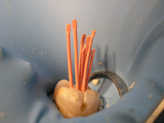|
|
 |
| Table of Contents |
1.1. Introduction
1.1.1. Endodontics role in the General Plan of the Dental Proffesional Studies
1.1.2. General and specific objectives
1.1.1. Basic phases in endodontic therapy
1.1.2. Coments to the basic and supplementary bibliography
1.2. Historic background of endodontics
1.2.1. Development periods of endodontics
1.3. Contemporary endodontics
1.3.1. Conteporary concepts of the pulpless tooth
1.3.2. Relationship with other dental specialities
1.3.3. Indications
1.3.4. Contraindications
1.4. Popular but misconceived concepts towards endodontics
1.4.1. Dead tooth
1.4.2. Black tooth
1.4.3. Fragil tooth
1.4.4. An expensive treatment
1.4.5. Time consuming treatment
1.4.6. Low rate of success
1.4.7. Some alternative medicine disregard endodontic treatment
1.5. Ethics & deontology
1.5.1 Ethimology, definition and objective
1.6. Bioethics in endodontics
1.6.1. Bioethics principles
1.6.2. Bioethics in endodontics
1.6.3. Informed consent
1.7.. Axiology
1.7.1. Structural values and accesory values
1.7.2. Axiology en endodontics
|
| |
| Key words: |
|
| |
|
|
|
| |
RETURN TO SUBJECT 1, STUDY OF ENDODONTICS, SECTION 3, CONTEMPORARY ENDODONTICS
|
SUGGESTED ARTICLE ABSTRACT
Nonsurgical Management of a Dilacerated Maxillary Lateral Incisor with Type III Dens Invaginatus: A Case Report
Tom G. Gound, DDS, MS, and David Maixner, DDS
Type III dens invaginatus is a developmental anomaly characterized by an enamel-lined channel that originates on the coronal surface and passes epically through part or all of the root and exits into the periodontal ligament. In this case report, a 13-yr-old male had a Type III dens that same level, the midroot level of tooth #7. At that same level, the root dilacerated severely to the mesial, and a periradicular radiolucency was present on the distal. A 12-mmperiodontal defect was present on tooth #6 and sinus tract was present. All maxillary anterior teeth responded normally to pulp vitality testing, and no other abnormal probing depths were present. The channel opening in the crown was located, and the channel was negotiated, enlarged, and filled with calcium hydroxide. Thirteen week later, the probing was normal and the canal was obturated with gutta-percha and restored. Two-and-6-yr recalls showed complete healing of the bony defects and continued normal responses to vitality testing.
Gound, Tom G. NONSURGICAL MANAGEMENT OF A DILACERATED MAXILLARY LATERAL INCISOR WITH TYPE III DENS INVAGINATUS: A CASE REPORT. JOE. Jun 2004;29(6):448-451
Investigated by Rita Vanessa Quintana Santiago, Student group 2622 (2008) FES Iztacala, UNAM
|
return to TOP |
|

